
still need the previous edition?
![]() .Events .Moon .Planets .Major Events .Minor Planets, NEOs .Comets .Shooting Stars .Occultations .Sun .check more! (occultations observers are advised to check in 'Events', and to turn to such dedicated sites like the I.O.T.A).
.Events .Moon .Planets .Major Events .Minor Planets, NEOs .Comets .Shooting Stars .Occultations .Sun .check more! (occultations observers are advised to check in 'Events', and to turn to such dedicated sites like the I.O.T.A). ![]() According to our policy, our site is now DST for the northern hemisphere, and ST for the southern hemisphere! check more details. don't forget to check the weather! For the US: the NOAA . color codes: Wwd worldwide, UsA USA-Americas, EuA Europe-Africa, AsP Asia-Pacific, Chk Check for Your Zone. check the site's concept and the instructions of use
According to our policy, our site is now DST for the northern hemisphere, and ST for the southern hemisphere! check more details. don't forget to check the weather! For the US: the NOAA . color codes: Wwd worldwide, UsA USA-Americas, EuA Europe-Africa, AsP Asia-Pacific, Chk Check for Your Zone. check the site's concept and the instructions of use
![]()
![]() Editor's Choice Fine Picture Archives
Editor's Choice Fine Picture Archives ![]() Editor's Choice Sky At
Editor's Choice Sky At ![]()
![]()
![]() Tech News
Tech News ![]() color codes: Wwd worldwide, UsA USA-Americas, EuA Europe-Africa, AsP Asia-Pacific, Chk Check for Your Zone. check the site's concept and the instructions of use
color codes: Wwd worldwide, UsA USA-Americas, EuA Europe-Africa, AsP Asia-Pacific, Chk Check for Your Zone. check the site's concept and the instructions of use
| Tweet |
.Events Seen All Month Long .Ephemerides Proper
(data from the former yearly ephemerides generator at Fred Espenak's NASA's eclipse website; miscellaneous data with the 'Astronomical Phenomena for The Year 2020,' a joint work by the United Kingdom Hydrographic Office and the U.S. Naval Observatory; to be found at the latter's site; all time UT except otherwise stated)
Wwd All June, Jupiter and Saturn are seen close together as they are rising as soon as about 11.05 p.m. local time in the northern hemisphere, 9 p.m. at the Tropic or in 8 p.m. the southern hemisphere. Moon will come to add. Fine visual or photographic opportunities!
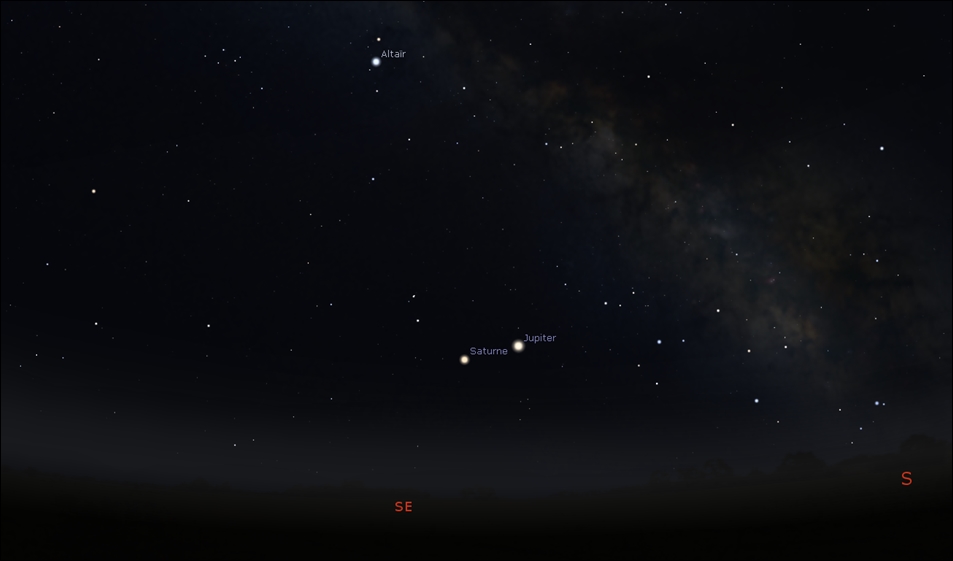 | Jupiter close to Saturn in June! picture site 'Amateur Astronomy' based upon the Stellarium software |
Wwd Beginng mid-June where Venus rising like a morning star by dawn, it will be seen moving by Aldebaran, the bright star to constellation Taurus, the Bull. Fine. Moon will add!
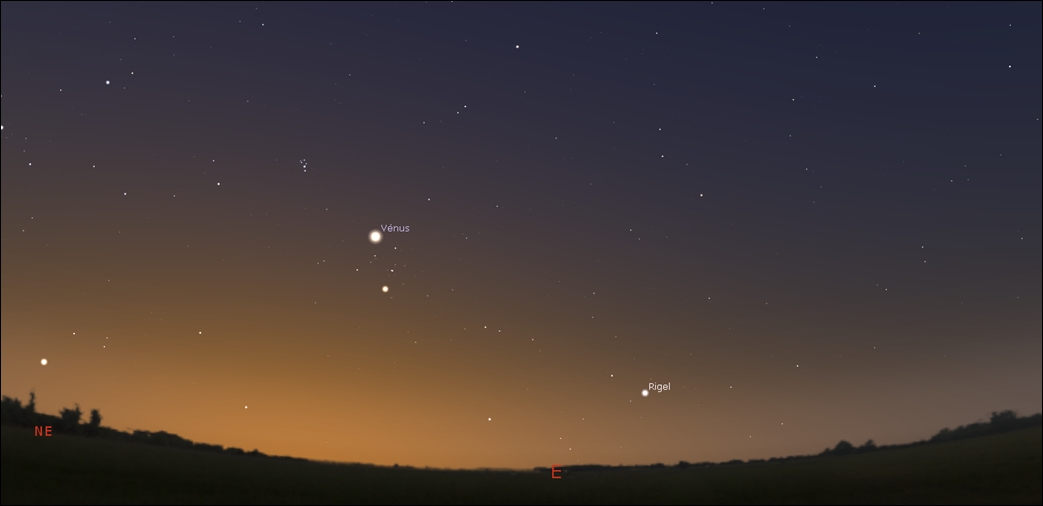 | Venus when climbing back like a morning star, is passing by Aldebaran, the bright star to constellation Taurus, the Bull! picture site 'Amateur Astronomy' based upon the Stellarium software |
Chk Regulus is a evening star in the northern hemisphere only as, in the southern hemisphere, some bright stars of the northern Great Winter Sky are
1 ![]() Wwd Une curiosité: les étoiles filantes Ariétides sont actives de fin mai à début juillet plus de détails
Wwd Une curiosité: les étoiles filantes Ariétides sont actives de fin mai à début juillet plus de détails
3 Wwd Moon is at its perigee at 03:36 UT (distances non available)
5 Wwd The second lunar eclipse in 2020, a penumbral lunar eclipse is occuring today. check more
6 Wwd Moon is at a descending node at 18:10 UT
Between 6 to 9 Wwd At all latitudes waning gibbous Moon, may be variedly seen close to both Jupiter and Saturn! That occurs on Jun. 6 and 7 in the USA-Americas area, on Jun.8 in Europe-Africa, and one Jun. 8-9 for the Asia-Pacific one
7 Wwd Moon reaches a southernmost declination at 16:22 UT
15 Wwd Moon is at its apogee at 00:56 UT (distances non available)
18 Wwd Tomorrow morning by dawn at all latitudes, last crescent a fine show, is seen close to Venus ascending like a morning star. Check that!
19 Wwd There is a occultation of Venus today by Moon! check more at Occultations; check more too at such sites like "The International Occultation Timing Association" (I.O.T.A.)
20 Wwd It is the summer solstice today, by 21:43! check more details about Earth's seasons with our tutorial Seasons
21 (1) Wwd The first solar eclipse for that year occurs today, a annular eclipse. check more
21 (2) Wwd Moon is at a ascending node at 04:24 UT
22 Wwd Moon reaches a northernmost declination at 03:56 UT
25 Wwd First crescent by all latitudes close to Regulus tonight, the bright star to constellation Leo, the Lion. Fine! The show may be seen as soon as by twilight
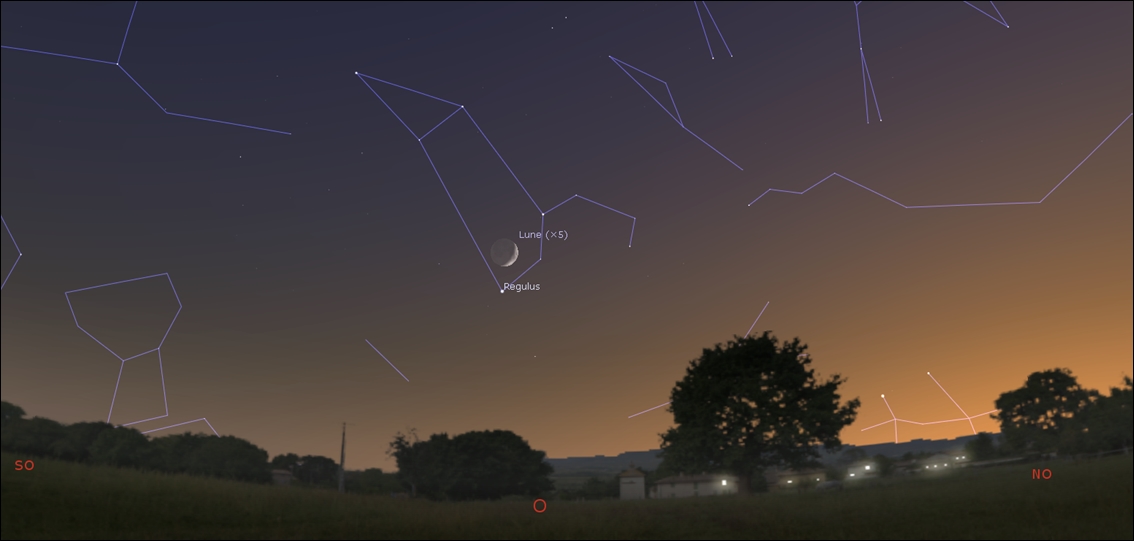 | Moon close to Regulus, the bright star to constellation Leo, the Lion! picture site 'Amateur Astronomy' based upon the Stellarium software |
30 Wwd Moon is at its perigee at 02:09 UT (distances non available)
Occultations observers are advised to turn to such dedicated sites like the I.O.T.A as they may also check below at our Occultation section
Full Moon is on June 5th, at 19:12 UT
Last Quarter is on June 13th, at 06:24 UT
New Moon is on June 21st, at 06:41 UT
First Quarter is on June 28th, at 08:16 UT
(source: ephemeris generator at Fred Espenak's NASA's eclipse website)
for what a remarkable configuration of a planet is, check our tutorial 'Planets Apparent Motion'
Mercury is reaching a greatest eastern elongation at 12:59, on June 4th. Despite that, Mercury is not seen in the northern hemisphere or badly at the Tropics or the southern hemisphere
Venus is reaching a inferior conjunction on Jun. 3rd, 2020 by 17:42. Hence Venus is mostly unseen worldwide as its reappears like a climbing morning star since mid-June at the Tropics and the southern hemisphere as the show will be at about 10 degree of altitude in the northern hemisphere
Mars Mars Observation Campaign! is rising by 1:50 a.m. local time in the northern hemisphere, 0:35 a.m .at the Tropics and 0:20 a.m. in the southern hemisphere. Mars is a about the half of the apparent diameter it will reach in October, at its opposition. A Mars observation campaign, the Mars Observation Campaign 2020-2021 is unfolding from March 19th, 2020 when Mars will reach 6" of apparent diameter, until March 10th, 2021 when Mars will be back to that value, a value afficionados deem the least observable. check more at our Mars Observation Campaign 2020-2021 page
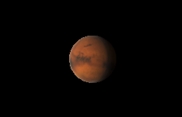 | Mars Observation Campaign! Mars to reach about half its apparent diameter of October 2020, at the opposition! picture site 'Amateur Astronomy' based upon the Celestia software |
Jupiter Tending to its Best! is closing to a opposition next month. The gas giant is now rising as soon as about 11.05 p.m. local time in the northern hemisphere, 9 p.m. at the Tropics or 8 p.m. in the southern hemisphere
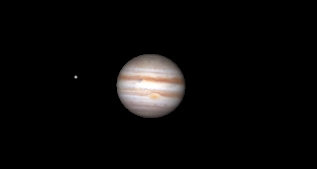 | Jupiter now tending to its best! picture site 'Amateur Astronomy' based upon the Stellarium software |
Saturn Tending to its Best! is closing to a opposition next July. Saturn is now rising as soon as about 11.05 p.m. local time in the northern hemisphere, 9 p.m. at the Tropics or 8 p.m. in the southern hemisphere. Following a ring aperture maximum, rings now are closing
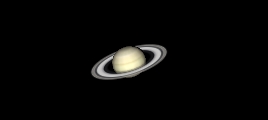 | Saturn now tending to its best! picture site 'Amateur Astronomy' based upon the Celestia software |
Uranus is rising by 3:45 a.m. local time in the northern hemisphere, 3:30 a.m. at the Tropics and in 4 a.m. in the southern hemisphere
Neptune is rising by 1:50 a.m. local time in the northern hemisphere, 0:35 a.m .at the Tropics and 0:20 a.m. in the southern hemisphere
Pluto Tending to its Best! is tending to its opposition which will occur next month. The faraway world is now rising as soon as about 11.05 p.m. local time in the northern hemisphere, 9 p.m. at the Tropics or 8 p.m. in the southern hemisphere (according to the International Astronomical Union (IAU) since 2006, Pluto is not considered a planet anymore, but categorized like a dwarf planet instead along with Ceres, Eris, Makemake, and Haumea, and the prototype of a new category of 'trans-Neptunian', 'Pluto-class' objects)
 | Pluto now tending to its best! picture site 'Amateur Astronomy' based upon the Celestia software |
The Penumbral Lunar Eclipse of June 5th, 2020
The Annular Solar Eclipse of June 21st, 2020
This second lunar eclipse in 2020 is a penumbral lunar eclipse, the June 5th, 2020 penumbral lunar eclipse. With the Moon, for the penumbral lunar eclipse of June 5th, 2020, dipping for some more than half the lunar disk into the Earth's northern area of the penumbra, that eclipse will be of interest and the southern regions of Moon most affected! The whole of the eclipse is observable in a area extending from the eastern parts of Africa, Asia minor, and Russia down to most of Australia. Like usual either side on that area, a one will have the eclipse already en cours at moonrise and a other, the eclipse interrupted by moonset. check our page dedicated to that event
That first solar eclipse in 2020 is a annular eclipse occurring on June 21st, 2020. The eclipse will unfold from the eastern reaches of the Republic of The Congo up to about the U.S. island of Guam. Like usual, a partial solar eclipse is seen either side of the line of centrality. The closer the central line, the more indented the Sun. check our page dedicated to that event
| CAUTION! OBSERVING A SUN ECLIPSE IS DANGEROUS AND MAY CAUSE IRREVERSIBLE EYE DAMAGE, UP TO BLINDNESS, ANNULAR AND PARTIAL ECLIPSES INCLUDED! Observing a Sun eclipse necessitates DEDICATED SAFE TECHNIQUES! |
Minor planets are those biggest asteroids in the Asteroid Belt which may be easily observed by amateurs from the Earth, namely Ceres, Pallas, Juno, and Vesta (due to the new categorization by the International Astronomical Union (IAU) by 2006, Ceres belongs to the 5 dwarf planets in the solar system with Pluto, Eris, Makemake, and Haumea). check data and charts at our section Minor Planets on the yearly Calendar page as our tutorial 'Asteroids and Asteroid Hunting' is of help too. Any remarkable event linked to a minor planet may have a notice here below
Some small asteroids dubbed Near-Earth Objects (NEOs) are regularly making close approaches at Earth. People interested in such close approaches may obtain recent and upcoming data at NASA (JPL) site Center for Near Earth Object Studies (CNEOS) (their section "Close Approaches"). Miscellaneous data are available. For further observational purposes, check at their ephemeris Generator (via Tools/Neo DB Query)
. For more about NEOs see tutorial "
Once every time, the solar system treats us with a remarkable comet, a eery view spanning up to thirty degrees of sky! Most of the time however comets are the domain of dedicated observers as mostly weak and, at the most, hovering at the limit of the naked-eye visibility. A good site to get information about current such comets is the British Astronomical Association Comet Section page or also the Weekly Information about Bright Comets page (which often points to comets close to the visual magnitude). Our 'Comets and Comet Hunting' tutorial will also be helpful. Remarkable comets otherwise usually will be presented below!
->note: shooting stars afficionados will be aware of checking Moon at the dates of the showers
for more about the meteor showers of this month, for possible other meteor showers for this month, and for more about shooting stars, generally, see our tutorial "Shooting Stars"
Each month, Moon occults some relatively bright stars, that is the Moon, beginning either with its bright or its dark visible face, is passing in front of a star. This is called an occultation. The Pleiades, on the other hand, due to their position near the eclipic, are often occulted by Moon too. Some planets, at last, along the year, may be occulted by Moon or they themselves, or their satellites, may be seen too occulting a star. The asteroids too may occult stars. Yearly lists of such phenomenons are to be found at Sky & Telescope/SkyTonight.com, either in their newsstand issues or at their site, as a list of occultations of most brilliant stars, the planets and the Pleiades are available at the I.O.T.A site (I.O.T.A. stands for "The International Occultation Timing Association"). Most notable occultations are signaled below. Are given here only planetary occultations; for bright stars occultations, check at such sites like "The International Occultation Timing Association" (I.O.T.A.)
Venus back is occulted by Moon on Jun. 19th, 2020 by 09:00 UT! The show is available for Azores, Canary Islands,north and eastern Canada,Greenland, north westernhalf of Europe, northern andcentral Russia, northernMongolia. check more at such sites like "The International Occultation Timing Association" (I.O.T.A.)
check on this site for more about occultations, theoretically
| CAUTION! OBSERVING THE SUN IS DANGEROUS AND REQUIRES DEDICATED SAFE TECHNIQUES! |